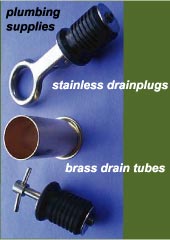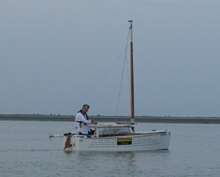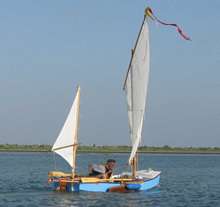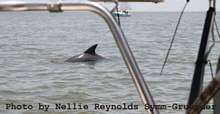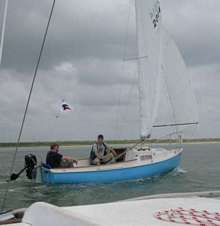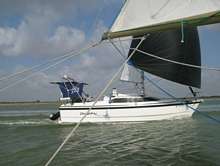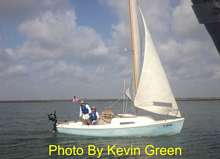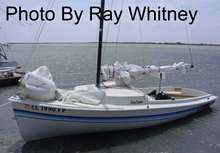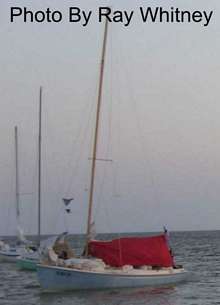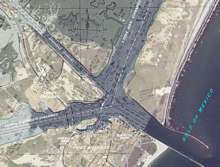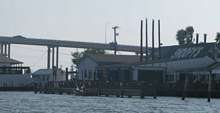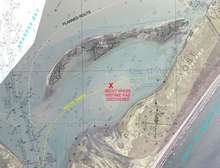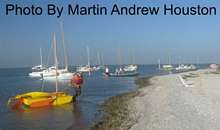
 Custom Search
|
| boat plans |
| canoe/kayak |
| electrical |
| epoxy/supplies |
| fasteners |
| gear |
| gift certificates |
| hardware |
| hatches/deckplates |
| media |
| paint/varnish |
| rope/line |
| rowing/sculling |
| sailmaking |
| sails |
| tools |
| join |
| home |
| indexes |
| classifieds |
| calendar |
| archives |
| about |
| links |
| Join Duckworks Get free newsletter CLICK HERE |
|
|
| 2014 Texas 200 - Part Two |
by John Alesch
- Austin, Texas - USA |
Part One - Part Two - Part ThreeTuesday morning I woke early to the Duck fleet and other small boats heading out at first light. The wind was considerably lighter than the day before. The Ducks sailed, camped, and left as a group during the event. I pulled out my camera and took pictures of them as they left including the now famous Chevy Duck. One by one they left the beach and headed down the channel.
After the small boats and Ducks left, I cleaned up the boat a bit while I waited for my crew to show up. I wasn’t even sure where they had camped. Only thing I knew was that it was a lot further down the beach than I was willing to walk. I adjusted some of the rigging and got the sails untied to get ready to raise them. I started to wonder after 7:30am if they were still sleeping. I found some other things to do while I waited. After a while I saw them coming from the very far end of the beach. Glad I didn’t walk down there.
When Mark and Michael reached the boat, we got their gear loaded. Mark showed me his damaged poles and said he didn’t know if they would work a second night. I told him I had my two-man tent on board they could use if they wanted to use it. I had brought it in case sleeping in the cabin didn’t work out.
Mark said he found the guy that the cushion belonged to. He said that the sailor had told him they had abandoned his boat at Port Mansfield after several attempts to sail it in the high winds. He then went with his friends on their boat and left his boat at Port Mansfield to be retrieved at the end of the event. He wasn’t the only capsize on Monday, there were others. Once things were loaded we hoisted the sails, released the anchor from shore and tried to push the boat out. We had sailed easily in, but it seemed shallower pushing out. We assumed that tide may have been lower. On this part of the coast the tide doesn’t fluctuate much more than a foot, plus or minus. We got out to where we could sail, but only managed to cross the channel and ground again. We soon got going and headed down the channel. The winds were lighter than the previous day - a welcome relief. We sailed under full sail, no reefs today. We coasted along and passed Matt’s Mariner that was sailing under main only while they had their morning coffee. They would pass us later after they put up their genoa. As we sailed downwind, we were unable to use the whisker pole for the jib as it was damaged. The whisker pole would be unavailable to us the rest of the week. As we passed a few boats, we could see the bulk of the fleet ahead of us, and several boats behind us still leaving camp. It was a nice day for sailing, although a little cloudier than normal. A few hours after we started as we got out of the land cut into more open water we started to see dolphins surfacing. We enjoyed watching them. Trying to get pictures of them was difficult. You can watch where they dive below the surface, follow along and see them resurface, but when trying to do the same technique with a camera they come up in a place you just don’t anticipate.
Ahead of us we could see Kevin’s McGreggor 26x with his pirate flag and his large black UPS sail. We closed on him and then passed him. A little while later Kevin passed us, and soon Matt’s Mariner caught up to us and then passed us both. As we approached the bulk of the fleet, the wind began to drop off a bit. In the distance we could see the yellow sails that most of the Ducks were using. We soon passed Kevin again and started to catch up to the fleet. By noon the wind had really become light, we could still make headway, but speed wasn’t great. We began to pass up the Ducks and other small boats that were hardly moving.
Just before 2:00pm the wind started to pick up again and was shifting more to the east. The clouds had cleared out with the freshening wind and the skies became clear. The boat began to pick up speed and we began to pass up boats that were ahead of us. We were probably a couple hours away from camp 2 at the point the wind freshened.
As the afternoon wore on the wind continued to freshen. This is common on the Texas coast as the day heats up. In the morning, most of the fleet was ahead of us, now the bulk of the fleet was behind us. We started to see some of the boats ahead of us start to turn out of the channel and head for camp 2.
We were following behind an Eclipse 6.7 and noticed they weren’t turning off where most of the other boats had turned for camp. We made our turn and decided the boat ahead of us had a different course planned that maybe had deeper water. We later found out that their rudder had popped out of the gudgeons and they had lost steerage causing some hectic moments. The Texas 200 is known to be hard on rudders. As we turned off out of the channel, we could see bottom in some places. We brought the centerboard up some to reduce our draft. We continued on our course watching the water depth as we went. Several boats where already anchored in the shallow water of the camp anchorage. We sailed as close as we could get to shore. Once the sails were down, Michael pulled the boat a little shallower and set the anchor. We checked for cell phone signal and had none again. My cell phone briefly had a very weak signal, but then it was lost. I sent an “Everything OK” message out on the SPOT to try to notify anyone following us that we were OK despite no contact. Mark and Michael went ashore to find a place to camp. Hamilton Cowie and John Gruden from the Day Sailer “Reservoir Dog” came by the boat and asked if I wanted to see their boat. They had made some modifications per articles I had written from my past Texas 200s which I had sailed my Day Sailer. They also had their own improvements. We had been in e-mail contact prior to the event.
We walked over to their boat in the shallow water, perhaps a foot or so deep. The water was clearer here than at camp 1 and not near as muddy. The bottom had more of a sand/mud mixture. It was a little hard for me to walk, but not too bad. We talked to a few other sailors along the way. Their Day Sailer was a newer boat than mine and was a very good looking boat. They showed me what they had done to prepare it and we talked about Day Sailers for a while. When I got back to the boat, Mark and Michael were back from there exploration of the sand and grass beach. This beach had some places that were better protected from the wind, although the wind was considerably less than the previous day. Several people were in the water relaxing and talking. I thought about getting in the water, but sat in the cockpit with Mark and Michael instead. Mark then asked me if they could sleep in the cockpit instead of trying to set up their damaged tent. I said that wouldn’t be a problem. If we hadn’t had so much packed into the cabin, there would have been room for someone to sleep there. But we had supplies for a week for three people in the boat and a really big cooler and there was just barely enough room for me.
The sun was hot in the late afternoon with no clouds in the sky. No shade onshore either. I then got the idea to pull out my cockpit tent and set it up to provide shade. I had bought the used cockpit tent on eBay about six years ago and never used it, even though it has been carried on every Texas 200 I’ve been on. We got it set up despite not having the right attachments for the rub rail. We manage to get it up anyhow. The lower edges were designed to roll up, so we did that. The air blowing through the cockpit without the sun beating down on us made things a lot more comfortable.
The Duck fleet arrived at camp and beached. Shortly after arriving they left and headed further north about 7 or 8 miles to reduce their sail the following day which was going to be longer than each of the previous days. They had a few hours they could sail before it would get dark. When the sun had set a bit and was not as hot, we took down the cockpit tent as we no longer needed the protection from the sun. With the offshore breezes all night, mosquitoes were not a problem. We got Mark and Michael’s gear out of the cabin into the cockpit. I moved into the cabin to get out of the way. After organizing the cockpit a bit, Mark pulled out his propane stove to cook some dinner. Michael got what he needed out of the coolers. The food I brought for myself did not require refrigeration, while my crew brought food that needed to be kept cold. I usually don’t eat much when sailing the Texas 200, but accepted the offer of some of the food that was cooked. As I recall, Mark had cooked up some vegetables and some chicken. It was way better than the Hormel microwave meal that I planned to eat cold and I thanked them for it. They offered more than I could eat, so I declined as I could barely eat what they gave me, but it was most appreciated. After eating they finished getting their sleeping arrangements set up and we bedded down for the night. Before going to sleep, I checked if I had a 4G signal for my Kindle tablet. No signal, so there would be no report to the Day Sailer forum or the Mariner forum. I put the tablet on a charger for the night and went to sleep. Wednesday morning we woke early. Several boats had left at first light and were already headed north. Our goal today was to sail to camp 3 at Pauls Mott. This would be a long days’ sail. The winds were around 10 knots. Not only would today be a long sail, but we would be crossing Corpus Christi Bay and pass through the ferries at the highway crossing at Port Aransas. There is no bridge where the highway crosses at Port Aransas so the State of Texas maintains a fleet of ferries to get cars across. They operate every day, 24 hours a day. We also might have to deal with shipping traffic in both the Corpus Christi Channel and Lydia Ann Channel which meet at an opening to the gulf which means large ocean going ships can come through as well as barges.
Mark and Michael had commented that it had been a mistake to take down the boom tent before they went to sleep as dew had settled on them during the night, giving them a chill. I remembered that happening to me in 2011 the one night we slept on the Day Sailer with no boom tent up. We stowed the gear from the cockpit into the cabin. We also put enough water bottles in a canvas bag for what we drink during the day. We had filled the water bottle bag each day before heading out. Our water was stored on the quarter berth section under the cockpit. The bag made it easier to get water during the day. As we raised sails, several boats were starting to leave, and like us several more were getting ready. The fastest boats would take their time, have breakfast, then leave. I had remembered using this camp area in 2011, and that year it was an easy sail out to the channel. Not this year however. We had only gone a few hundred yards when the centerboard (which was only partially down) hit bottom. We pulled the board up all the way and Michael got off the boat in less than knee deep water. He pushed us off the high spot we had grounded on and got back aboard. We sailed another short distance and grounded again. We noticed other boats having the same problem. Michael went over the side again to push us off. This time the water got deeper a lot faster and Mark had to help get him back on board. We cleared our next grounding by just raising the centerboard, then finally we weren’t hitting bottom anymore. We had passed a few boats that had pulled out ahead of us. We were now in the channel and on course. We got out some Clif bars and jerky for breakfast.
As we sailed up the channel we passed Kelly Davis in his rowboat. He was attempting to row the whole distance, but pulled out at Aransas Pass. He made it over half way. Soon after passing Kelly, we reached Marker 37 where there is a marina and a place called Snoopy’s. Matt in the other Mariner had left well ahead of us and when we reached this point, we could see him tied up at the dock. He was getting an “ice” resupply. There were several other boats tied up as well getting ice re-supply. We still had ice in the big Yeti cooler. Mark had done a good job of preparing the cooler for the trip by keeping ice in it for a week and it was paying off. We also only accessed this cooler in the evenings, so it was closed most of the time helping to preserve the ice blocks Mark had placed in it before we left. Anything that needed to be kept cold and accessed during the day was in a small cooler. We decided to not stop and head for Corpus Christi Bay. We passed Snoopy’s and sailed under the Kennedy Causeway Bridge and into the channel which would lead us to the bay. Along the channel we could see birds standing in the shallows along each side. As we sailed along we were soon joined by dolphins surfacing alongside the boat. We saw a couple young dolphins as well. One dolphin would swim alongside the bow switching sides from time to time. They seemed to know when someone was trying to take a picture because they would suddenly dive below the surface and never surface where you would expect them too. We really enjoyed watching them play. As we reached the bay, the dolphins moved to the next boat behind us. Consulting our charts as we came out of the channel we looked for water that would be deep enough to sail before we made a slight turn to starboard. We were no longer going to follow the channel markers along the ICW, but instead were going to cut across the bay passing between Mustang Island and Shamrock Island. Shamrock Island is a bird sanctuary and landing on the island is not allowed. The sail across the bay was enjoyable with good winds and not any large chop. There is a shallow place along the route between the islands and Mark wanted to get some navigation practice, so he was at the helm. As we got close to the bird sanctuary, Michael got out his camera to see if any good pictures were to be had, but found very few. Once past the shallow area, our next goal was Corpus Christi Channel heading to Port Aransas. From the bay we would make a turn to starboard and sail northeast up the channel after navigating through Stingray Hole. Stingray Hole is a narrow twisty channel. One of the warnings about Stingray Hole is that if a large ship is passing through the main channel when trying to get through it, the water can be sucked out leaving a boat high and dry for a short time. We were fortunate there were no large ships when we went through. Mark again took the helm to navigate through this area. We only bumped bottom once, and made our turn to starboard to get out into the main channel. We sailed up the channel staying fairly close to the wind so we could stay on the south side of the channel. The wind had gotten a little stronger, which is common as the day gets hotter. We wanted to stay as close as possible to the south shore to provide more maneuvering room going through the ferry crossing. We also did not want to have to tack while passing the ferries. We were heeling a fair amount as we moved down the channel and both Michael and I would hike out on the rail as needed. I rarely hiked out on my Day Sailer when sailing, but was really comfortable hiking out on the rail of the Mariner. As we headed down the channel we saw a barge moving in our direction. It was closer to the north side of the channel so we were pretty sure we could pass it without a problem. The Corpus Christi Channel is about three times wider than the land cut providing much more room. Finally, we got to the ferry crossing and we were able to get past them without incident. The ferry captains are very good at avoiding us.
We passed the ferries and headed to where we needed to turn to port and head north again up Lydia Ann Channel. As we prepared to make our turn into the channel, we could see the “Duck Fleet” beached about half way up the channel. We made our turn and headed north. There were several barges parked on the north end of the channel, the Ducks were just south of them. There were also some people parasailing ahead of us. I took back over at helm to give Mark a break after being at the helm all the way up the channel. The course I planned to sail was around the west side of Mud Island as I always have done in the past. As we got to the north end of Lydia Ann Channel there were several young people buzzing around on jet skies. They didn’t appear to care about right of way, so we were wary of them. We were happy when we got past them.
We sailed on following the waypoints I had loaded in my GPS. Besides the waypoints for my intended route, I also had loaded waypoints for a route to the east of Mud Island going through Blind Pass. I did not intend to go through Blind Pass, but I was mistakenly following that set of waypoints. I wasn’t paying close enough attention to landmarks and took a route where there was shallow water and a very hard to find channel. We bumped bottom which I thought was unusual as I had never bumped bottom going around Mud Island in the past. After a second bump, I looked around, then at my GPS and my charts and realized I was headed to Blind Pass and that if we didn’t find the channel we would run out of deep water soon. My GPS showed the channel and I could see the area on my charts. I headed for the channel shown on the GPS. Luck was with us, we hit the very narrow channel. Slight course changes in the channel would cause us to bump. We brought up the centerboard less than halfway and pulled the rudder blade up to reduce draft. The rudder blade being brought up makes steering harder, a lot of pressure on the rudder. At the end of the channel we were going to need to turn to port and catch a channel that ran north about 10 to 20 feet off the shoreline. As we made our turn we again bumped. Michael was raising and lowering the centerboard as needed in the shallows. We found the channel we needed and made our turn to the north. This channel was a little wider and we were able to sail up it. As we sailed along, we saw a green Duck sailing on the other side of a mud flat, the area where we would have ended up if we had not found the channel. The Duck beached on the mud flat and it looked as though he was going to have to pull his boat across it. There was no way we could get close enough to assist him, so we continued on. We knew the rest of the Ducks would be along soon.
As we got to the end of Blind Pass we saw Pehr Jansson beached at the end of the channel waiting for the Ducks to catch up. Out of Blind Pass we made a turn to port to get back to the route I had intended to take. Out of the shallow water we got back on course and continued to sail down Aransas Bay heading north for Pauls Mott, our campsite for the night. Once on course, Mark offered to switch out with me at helm. As we were switching, somehow downward pressure was exerted on the tiller and it cracked at the rear bolt of the two bolts holding the tiller cheek pieces in place. We stopped trying to switch places and I stayed at helm. We surveyed the damage and determined if we were careful, we could sail the few miles we still needed to go to get to camp. The split in the wood ran from the rear bolt downward as it went forward, missing the forward bolt which was still holding well. Once we got to camp, we would switch out tillers with the spare one I had brought. I had brought the tiller from my Day Sailer and an old Rhodes 19 rudder blade (same as Mariner) as spare rudder parts. The Texas 200 is known to be rough on rudders, so I learned on past events that spare parts were a good idea to have. I had let Matt know I had them in case he had problems. We made it to Pauls Mott without losing the tiller. We beached on the point of Pauls Mott instead of sailing around the end through the reefs jutting out from it and then tacking into the camp area. I had capsized my Day Sailer doing that in 2012, I thought this might be easier. As the boat beached, Mark and Michael jumped out to start to pull the boat over to the camp area. Somehow Mark snagged his wristwatch on something and it was pulled off his wrist into the water. He and Michael quickly tried to find it until the water was so stirred up they could no longer see bottom. Mark decided to let the water settle before looking again. I had gotten out of the boat as well to help move it to the camp area. Mark and Michael pulled-pushed the boat faster than I could; so I let them take it while I walked straight across. They got the boat in place and Michael set the anchor on shore. As I walked over to the boat; I hit something slippery and lost my balance and fell down in about a foot of water. The water actually felt refreshing, so as long as I was already wet, I laid there for a few minutes, then got up and headed to the boat.
Once at the boat, we got the tiller off and got the Day Sailer tiller out. Both tillers were set up basically the same. Both had a Tiller Tamer mounted and were set up for a tiller extension. We switched out the tiller extension and attached the tiller to the rudder. The main difference between the two tillers was that the Day Sailer tiller was about six inches shorter than the Mariner tiller. It would work. Once the tiller was replaced; Mark set up his tarp over the boom as a cockpit cover. He thought the tarp might work better than the cockpit tent. He didn’t want to wake up with dew on them again. The Ducks had arrived and they were pulling their boats around the tip of Pauls Mott as we had done. Most of the fleet was there, although some boats were missing and presumed to have dropped out. We found out later a few had dropped out, a few were over on the ICW and did not make it to camp, but would continue on. We also had our first cell phone/4G coverage of the trip. One of the landmarks for Pauls Mott is an old trawler mast on the beach that with its’ spreaders make it look like a cross. I’ve heard that it was originally put up as a memorial to someone. When we arrived, someone had torn it down and it was half buried in the sand. Shortly after the “Duckers” arrived; they went over and set the mast back up. Everything was now right again at Pauls Mott. They did a great job. Once the tarp was up, Mark got out his stove and I crawled up into the cabin to get out of the way of his cooking. There wasn’t as much room in the cockpit after Mark and Michaels gear was out of the cabin. Mark cooked up some vegetables and some hamburger he had in the big cooler. He gave me two hamburger patties, but I told him the he and Michael should eat the second one as that would be too much food for me. After eating, and before the sun went down completely, Mark took a flashlight and went over to look for his watch. The water had cleared up and the waves were less with lighter winds. He was in luck, the flashlight reflected off the watch and he was able to retrieve it. He then headed back to the boat a happy camper. |
To comment on Duckworks articles, please visit one of the following:
|
 |

